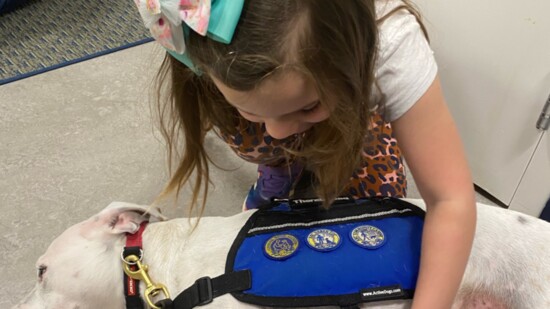Assisted-animal therapy, or animal therapy, is an evidence-based therapeutic approach that leverages the healing power of human-animal bonds and incorporates interactions with animals to improve physical, emotional, and mental well-being. Therapy animals differ from service animals in that service animals are paired with an individual who has a qualifying medical disability, whereas therapy animals are paired with a handler to form a credentialed team that interacts with the public at large.
When Paula Pinyan retired, she realized she wanted to become a handler for a therapy dog. “There’s just something about the power of animals that is beyond me,” Paula said. She reached out to Kimberly Brenowitz, the Executive Director and Founder of Paws for Life USA, who has over twenty years of experience. Kimberly agreed to assist. Together, they visited local shelters until they finally encountered Joy.
Joy had been in the shelter twice and was in desperate need of her “furever” home. She was scared, but despite her past, she had the one thing dogs need to become the best therapy animals: a natural love for people, something that is innate and impossible to teach. “All she wanted was to love and to be loved,” Paula said. Over the course of about a year, Paula taught Joy the meaning of safety, trust, and love, while Kimberly trained Paula to become a handler. Soon enough, Joy was fully trained and ready to begin her journey as a therapy dog with Paula by her side.
Joy’s natural ability to love people is complemented by her remarkable skill in sensing what the humans she interacts with need at any given moment. For instance, when Paws for Life USA visited a local nonprofit dedicated to helping children cope with grief, there was a young girl who was bouncing off the walls, interrupting conversations, and wreaking the kind of havoc only a child can create—until it was her turn to meet Joy. The young girl sat down to pet Joy, and her entire demeanor immediately transformed, reflecting an inexplicable calm.
In another instance, Paula took Joy to a local assisted living facility, where Joy interacted with various residents. For six months, Joy had been visiting one particular woman. On one visit, the woman’s family happened to be there. As they watched, the woman leaned over, petted Joy, and spoke a few words to her. The family, moved to tears, revealed they hadn’t heard their mother speak in months.
These stories are just a few of the many Paula shares about the profound impact Joy and other therapy animals have on people. “That’s the power of animals. They connect with people on a level that other people cannot,” Paula said.
Current research supports Paula’s observations. Interactions with therapy animals have been shown to lower cortisol levels; reduce blood pressure and heart rate; increase oxytocin, dopamine, and serotonin; alleviate hypervigilance in individuals with PTSD; and encourage social interaction, communication, and physical activity in individuals with autism, dementia, or social anxiety. While animal therapy should be used in conjunction with other forms of traditional therapy, “therapy animals are difficult to compare to other forms of therapy. It goes back to the human-animal bond. It is in its own category.”
Paws for Life USA visits a variety of settings, including schools, assisted living facilities, nursing homes, hospitals, and corporate offices such as Porsche and The Home Depot. They even participate in events like Dragon Con. For those who wish to get involved—whether with the intent to become a handler or to receive animal therapy—email admin@pawsforlifeusa.org for more information.
